

Porn companies adopt facial-recognition technology, encourage Instagram photos. Two porn companies are courting web surfers to upload photos they find online to the companies' free facial-recognition, face-matching database services.
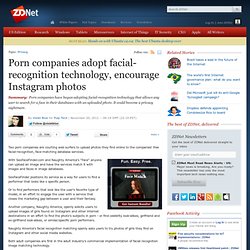
With SexFaceFinder.com and Naughty America's "Face" anyone can upload an image and have the services match it with images and faces in image databases. SexFaceFinder positions its service as a way for users to find a performer that looks like s specific person. Or to find performers that look like the user's favorite type of model, in an effort to engage the user with a service that closes the marketing gap between a user and their fantasy. Another company, Naughty America, openly solicits users to upload images of girls found on Instagram and other internet destinations in an effort to find the photo's subjects in porn - or find celebrity look-alikes, girlfriend and ex-girlfriend look-alikes, or similar/specific porn performers. Developments in Facial Recognition. Eventually, it will work.

You'll be able to wear a camera that will automatically recognize someone walking towards you, and a earpiece that will relay who that person is and maybe something about him. None of the technologies required to make this work are hard; it's just a matter of getting the error rate down low enough for it to be a useful system. And there have been a number of recent research results and news stories that illustrate what this new world might look like. The police want this sort of system. I already blogged about MORIS, an iris-scanning technology that several police forces in the U.S. are using.
A small camera fitted to the glasses can capture 400 facial images per second and send them to a central computer database storing up to 13 million faces. In the future, this sort of thing won't be limited to the police. Of course, there are false positives -- as there are with any system like this. Face recognition software can grab personal information, social security numbers. It is possible to identify strangers and gain their personal information - perhaps even their social security numbers - by using face recognition software and social media profiles, according to a new study by Carnegie Mellon University's Alessandro Acquisti and his research team.

The results of the study will be presented 4 August at Black Hat, a security conference in Las Vegas. "A person's face is the veritable link between her offline and online identities," said Acquisti, associate professor of information technology and public policy at the Heinz College and a Carnegie Mellon CyLab researcher.
"When we share tagged photos of ourselves online, it becomes possible for others to link our face to our names in situations where we would normally expect anonymity. " Une API pour reconnaitre les visages. FREE Face Recognition API, Face Recognition Software Apps for the masses – face.com.
The future of facial recognition: 7 fascinating facts. What’s on the screen in this photo?
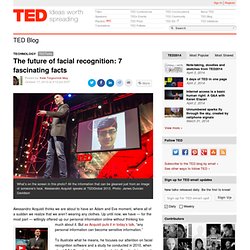
All the information that can be gleaned just from an image of someone’s face. Alessandro Acquisti speaks at TEDGlobal 2013. Photo: James Duncan Davidson Alessandro Acquisti thinks we are about to have an Adam and Eve moment, where all of a sudden we realize that we aren’t wearing any clothes. Up until now, we have — for the most part — willingly offered up our personal information online without thinking too much about it. FacialNetwork et Nametag. Camera search faces for match. Tech used in airports. Facial recognition software could allow ability to identify people from photographs on the internet.
By Daily Mail Reporter Updated: 10:05 GMT, 23 August 2010 A software company is developing revolutionary software which provides the ability to identify people from photographs posted on the internet.
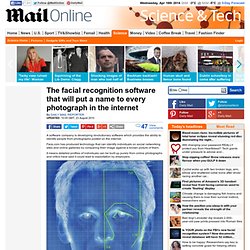
Face.com has produced technology that can identify individuals on social networking sites and online galleries by comparing their image against a known picture of them. It means detailed profiles of individuals can be built up purely from online photographs and critics have said it could lead to exploitation by employers. Privacy concerns: Face.com has made software available that can identify people from photographs on the internet through facial recognition technology (file picture) The software works be creating an algorithim of the face - a measurement of the arrangement of features including the eyes, nose and mouth.
The company says it is 90 per cent accurate when scanning typical images which appear on social networking sites. 'The technology is already being used by 5,000 developers. Identifying faces in a crowd in real-time. Published 2 September 2010 U.K. company develops a face recognition technology that can recognize individual faces in a crowd — and do so in seconds, even when they are moving, at a wide angle, or in poor light; the system captures and analyzes images and compares them to a database, and alerts security personnel if a match is made A new type of infrared security camera is being used to identify individual faces in real time.

The CheckPoint.S system from Guildford, Surrey, U.K. -based OmniPerception can recognize faces in seconds — even when they are moving, at a wide angle, or in poor light — by capturing and analyzing images and comparing them to a database. As well as alerting security teams to a suspect’s presence, the system can also be used to confirm the identity of invited guests entering a building. OmniPerception’s cameras emit near-infrared light, which is invisible to the human eye, and then use the reflected waves to scan the subject’s features. The Face Recognition Algorithm That Finally Outperforms Humans — The Physics arXiv Blog. Everybody has had the experience of not recognising someone they know—changes in pose, illumination and expression all make the task tricky.
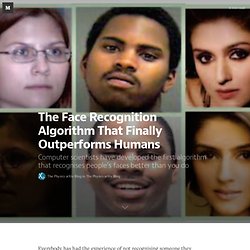
So it’s not surprising that computer vision systems have similar problems. Indeed, no computer vision system matches human performance despite years of work by computer scientists all over the world. That’s not to say that face recognition systems are poor. Far from it. The best systems can beat human performance in ideal conditions. Today, Chaochao Lu and Xiaoou Tang at the Chinese University of Hong Kong say they’ve done just that. The new system could finally make human-level face verification available in applications ranging from smart phone and computer game log-ons to security and passport control.
The first task in any programme of automated face verification is to build a decent dataset to test the algorithm with. As luck would have it, there is just such a dataset, known as the Labelled Faces in the Wild benchmark. How Machines Learned To Recognize Our Faces So Well. Earlier this year Facebook created DeepFace, a facial recognition system almost as accurate as the human brain.
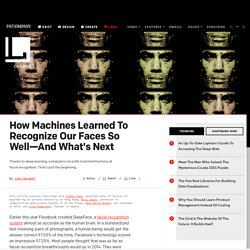
In a standardized test involving pairs of photographs, a human being would get the answer correct 97.53% of the time; Facebook's technology scored an impressive 97.25%. Most people thought that was as far as facial recognition breakthroughs would go in 2014. They were wrong. A few months after Facebook's breakthrough, the Multimedia Laboratory at the Chinese University of Hong Kong claims to have smashed Facebook’s record by building a recognition system that achieves a massive 99.15% accuracy rate—based on some truly innovative deep learning models. "This is strong evidence that deep learning is making artificial intelligence possible," says the university’s Xiaoou Tang, former head of Microsoft Asia’s Visual Computing group of Microsoft Asia. Smaller Datasets, Better Models "Facebook relied heavily on their vast amount of data," Tang says.